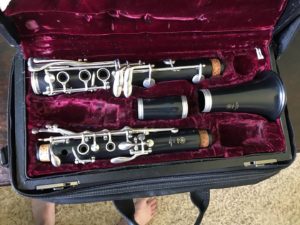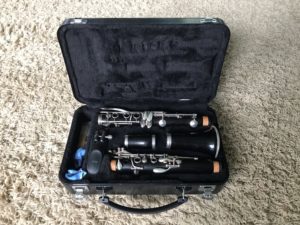Yamaha YCL-255 Student Clarinet


Background: This old Yamaha was a purchase of mine from my early days of buying clarinets. I found this thing at a chain of thrift stores known as McKay’s Used Books and Games for somewhere around $200 bucks. It came complete, with its case, a cleaning swap, and a stock mouthpiece and ligature combo. The instrument’s plating was rather worn, but mechanically it was in fine shape. I think all of the pads were original to the instrument as well, and all of them seemed to be sealing just fine so I didn’t opt to replace any of them. All I had to do to this old thing was give it a good cleaning, polish the keys, and do a couple of minor adjustments and this thing was playing well. And you better believe that it played.
General Info: This is a plastic student horn with nickel plated keywork and felt pads. This particular horn was manufactured approximately between 2010 and 2015, and the YCL-255 is still made and sold by Yamaha.
Playability and Tuning: This horn has to be the most free blowing student model clarinet I have ever played, and there was not a stuffy note anywhere on it. Tuning was quite good for a student horn, and I didn’t feel like I had to adjust very much at all to get the horn in tune. It had a pretty warm and centered sound with my Vandoren BD5 13, but it could get pretty loud and bright when needed. It handled these loud dynamics well and the tuning held quite stable and didn’t go flat at all and it could cut through nicely when needed. The horn was easy to control, and it responded well throughout all registers. It could play soft or loud with a good sound and pretty good intonation as well although it did tend to go a bit sharp in the chalumeau register when playing soft which is a common student horn thing. The BD5 13 helped out quite a bit with this and with a bit of adjustment I could play pretty well in tune while going soft. I was also shocked to find that even the throat Bb sounded pretty good and spoke well. Tuning was a bit sharp in the throat tone area as well but that could easily be navigated with some added fingers and a bit of adjustment. This horn played so well that I even played it in orchestra, wind ensemble and lessons in college for a few semesters and got nothing but good comments about my sound. I honestly liked this horn better than the wood professional horn I owned at the time, and this horn was also very consistent as far as pitch and playability were concerned from day to day which I really appreciated.
Construction and Build Quality: Keywork placement was pretty comfortable, especially for someone with small hands like me. I felt that the plating wear was quite surprising for a horn that I think was probably made between 2010 and 2015 or somewhere around there if I have my dates correct. Again, I don’t know the horn’s history prior to my acquisition of it so who knows what it has been through or if it had been cared for before I got it. But that was a minor point, especially after playing it. Regardless, I have found in my experience and observation that the nickel plating on some of the newer student horns just does not hold up well compared to older ones and I can certainly say that might be the case here. The build quality of the keywork itself is fine though, and the keys don’t bend easily which is something I often find on student horns. Body construction was quite solid, although the bell and barrel construction in particular seemed maybe just a bit thinner and lighter compared to my older Bundy and Vito horns. Also, the lack of a metal bell ring sort of made the bell construction feel a bit cheap as well. The presence of a bell ring is a personal preference of mine as I think it looks better cosmetically and gives a bit more weight to the bell. It doesn’t effect how the instrument plays as far as I know, I just think it looks and feels better. A side note is that the little yellow cleaning swap thing that Yamaha sells with their student clarinets is pretty useless. It is like this tiny little yellow foam type stuff on a weighted string that does not absorb any of the moisture and just spears it around inside the instrument. I would have expected a nicer cleaning swap from a brand such as Yamaha.
Case: The case you see pictured is not the original one. The case here is from a professional Yamaha YCL-650 and it was deteriorating and so I opted to switch its case out with the YCL-650 case because I was using it more at the time. The original case can be seen in the second photo with a different instrument in it. The original YCL-255 case was a black plastic hard case with nickel plated latches. The latches felt just a bit flimsy, but they closed securely and kept the case shut securely. The inside of the case is covered in soft black fabric that feels to be made with good quality. The case holds the instrument secure and neither the YCL-255 or the YCL-650 move around at all while being transported in this case. My only complaint is that I wish there was a little bit more storage for reeds and other accessories in the case.
Conclusion: I have since sold this horn and while there are days I regret it, but I needed the money and I really wasn’t using it much at the time after acquiring a professional horn per the requirements of my school’s clarinet studio. I do have the peace of mind knowing it is at least getting played in the band program I sold it too. In any case, I highly recommend the YCL-255 as it is a well constructed horn overall with great playing characteristics and it will last a student at any level a good long while. It would be a great backup/outdoor horn for a professional too. With a player that gets to know the instrument’s tendencies and a good mouthpiece, this thing can make some wonderful sounds that sound pro in my opinion.
